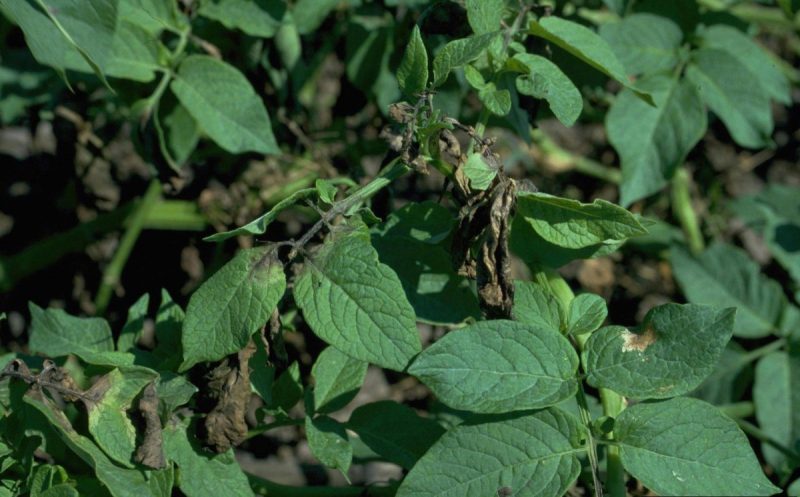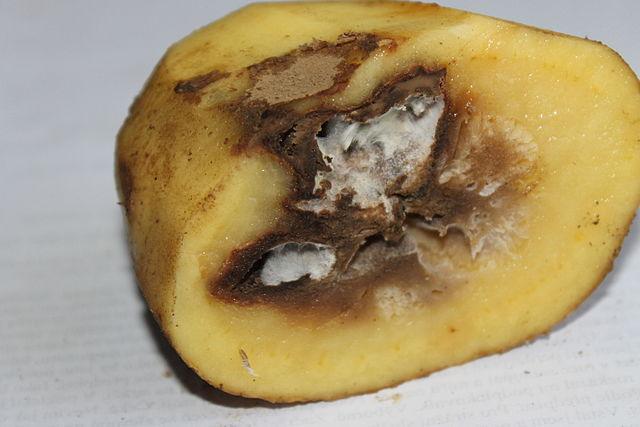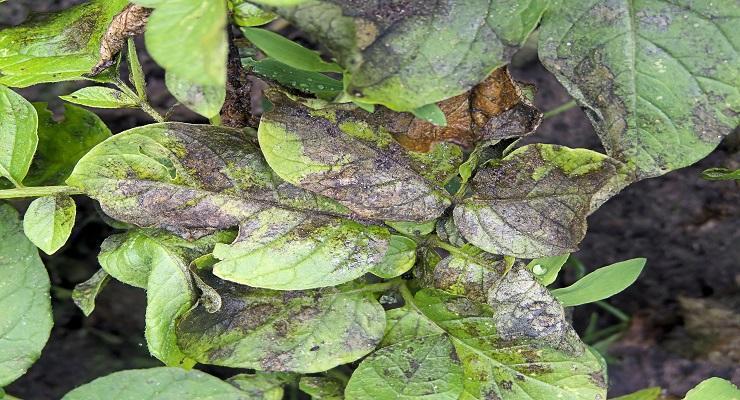Potato late blight (Phytophthora infestans) – identify and control

Potato late blight, Phytophthora infestans is native to South America (Peru, Chile). It was introduced to Europe in the first half of the 19th century.



Symptoms. The potato late blight is manifested on the aerial organs and on the tubers. The first symptoms are observed on the leaves in May-June, usually before the flowering of the crops. On the attacked leaves appear yellow spots, at first small, with a diffuse outline and more numerous at the edge of the leaflets. The spots gradually increase, turn brown, then brownish-black, and are surrounded by a yellow stripe, with irregular and diffuse edges.
On the underside of the leaf, at the periphery of the spots, there is a very fine, whitish fuzz, formed by sporangiophores and sporangia of the fungus. In relatively warm weather the down is very little distinct or no longer formed, and the spots stagnate in growth. In conditions of high humidity, the spots increase, being able to occupy the entire surface of the leaflets, which turn brown, dry, and darken.
On the stems, on the petioles of the leaves, and on the peduncles, there are elongated, blackish-brown spots of variable sizes. If the spots enclose the stem all around, they dry completely, from the level of the spot to its tip, together with all the leaves. On the attacked tubers, the late blight manifests itself in the form of brown, brown-gray, or blue spots, near which the periderm of the tuber is slightly submerged.
The pathogen is Phytophthora infestans that live as a parasite in the mesophyll of the leaf near the spots. The transmission of the disease from one year to another is ensured by the tubers attacked by a late blight that has remained in the stock of the planting material. They can be a source of infection only in the case of monoculture when they give plants sprouted after harvest already infected. However, if there is a crop rotation or at least a 3-year rotation, this source of infection should not be considered. From the tubers attacked by late blight appear browned shoots at the place where they catch the tubers, and on the shoots appear the first leaves with spotted leaflets on which spores appear (generalized primary infection). Spores can reach the surface of the earth by rising water from the ground and then cause new infections (secondary infections).
The first infections are observed 35 days after planting if the rainfall is low. Or, even faster if the precipitation level is higher. The spores of the fungus spread through the wind, at least 11 km/day. This can lead to the destruction of 100 ha in the presence of an outbreak of infection, in areas with heavy rainfall and moderate temperatures.
Prevention and control. To prevent and control this disease, it is recommended to use healthy tubers when planting. Planting is done at 10-15 cm, to help reduce late infections in soil tubers. During the potato blight infection, sprinkle irrigation of crops will be avoided. They promote the rapid spread of the disease. Before storage, the potatoes destined for planting will be sorted, removing the infected, damaged, cut, or injured tubers.
During the growing season treatments with specific fungicides are performed.
Recommended products
-
You can find products on a different store
Change Store -
You can find products on a different store
Change Store -
You can find products on a different store
Change Store -
You can find products on a different store
Change Store -
You can find products on a different store
Change Store -
You can find products on a different store
Change Store -
You can find products on a different store
Change Store -
You can find products on a different store
Change Store -
You can find products on a different store
Change Store -
You can find products on a different store
Change Store -
You can find products on a different store
Change Store -
You can find products on a different store
Change Store -
You can find products on a different store
Change Store -
You can find products on a different store
Change Store -
You can find products on a different store
Change Store -
You can find products on a different store
Change Store -
You can find products on a different store
Change Store -
You can find products on a different store
Change Store -
You can find products on a different store
Change Store -
You can find products on a different store
Change Store -
You can find products on a different store
Change Store -
You can find products on a different store
Change Store -
You can find products on a different store
Change Store -
You can find products on a different store
Change Store















































































































































































































































































































































































































































